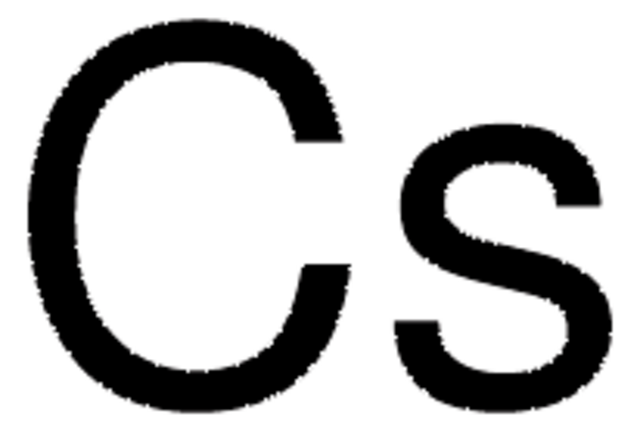203025
Cesium chloride
≥99.999% trace metals basis
Synonym(s):
Caesium chloride, Cesium monochloride
About This Item
Recommended Products
grade
for analytical purposes
Assay
≥99.999% trace metals basis
form
crystalline
impurities
≤10.0 ppm Trace Metal Analysis
mp
645 °C (lit.)
SMILES string
[Cl-].[Cs+]
InChI
1S/ClH.Cs/h1H;/q;+1/p-1
InChI key
AIYUHDOJVYHVIT-UHFFFAOYSA-M
Looking for similar products? Visit Product Comparison Guide
Related Categories
General description
Application
- As crystal seeds to enhance the coverage of the CH3NH3PbI3−xClx absorber layer in perovskite solar cells. It helps to boost the power conversion efficiency of solar cells.
- As a medium to synthesize N and P-codoped carbon nanospheres for application in fuel cells and zinc-air batteries.
- To fabricate silicon nanopillars for solar cells, batteries, light-emitting diodes, etc.
- To enhance the thermal stability of polyoxometalates(used as electrode materials for lithium-ion batteries).
- To synthesize the lead-free halide double perovskite Cs2AgInCl6 with excellent moisture, light, and heat resistance. This material shows great potential for various optoelectronic applications, including photovoltaics.
Signal Word
Warning
Hazard Statements
Precautionary Statements
Hazard Classifications
Repr. 2
Storage Class Code
13 - Non Combustible Solids
WGK
WGK 1
Flash Point(F)
Not applicable
Flash Point(C)
Not applicable
Personal Protective Equipment
Choose from one of the most recent versions:
Already Own This Product?
Find documentation for the products that you have recently purchased in the Document Library.
Customers Also Viewed
Articles
Colloidal quantum dots (CQDs) are semiconducting crystals of only a few nanometers (ca. 2–12 nm) coated with ligand/surfactant molecules to help prevent agglomeration.
Our team of scientists has experience in all areas of research including Life Science, Material Science, Chemical Synthesis, Chromatography, Analytical and many others.
Contact Technical Service



